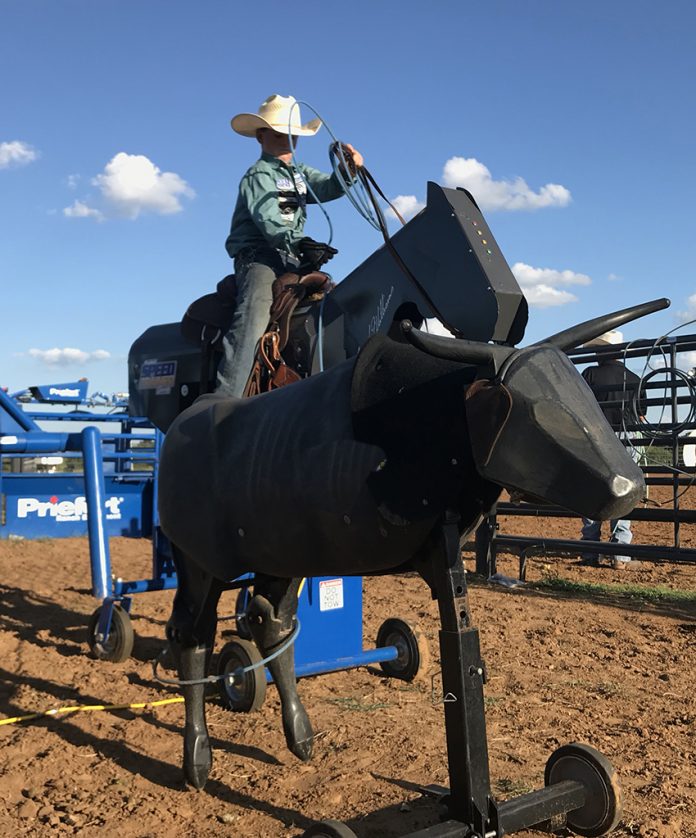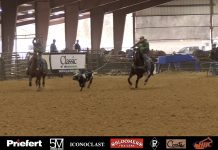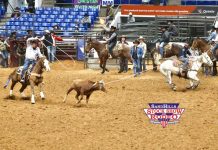Breaking it Down by Speed Williams – April 2024
I doubt there’s a more complex subject that’s been debated among the top ropers in the world than heeling. There are so many different opinions and approaches to heeling steers. Throughout my career I’ve had a lot of conversations with my partners, and other gold buckle heelers, and found there are many different ideas on teaching the fundamentals of heeling. One of the unique things about the Speed Trainer is it can be used in so many ways and positions.
Sometimes I put my son on the Speed Trainer and move the dummy right under its neck with the butt as close to the Speed Trainer as I can get it. I then tell him to set a “gate” with his loop and have it stand up without going under the legs. Then, I’ll ask him to rope in the same position but have the bottom strand of his loop come through under the legs. Then, I’ll tell him I want the right leg roped and only a trap in front of the left leg. You’re probably wondering why I would ask for three different loops on one cow. I want him to understand what his hand does and how to place the rope under the cow and have complete control of his top and bottom strand.
If you’ve ever watched my son heel, he has the ability to engage his horse with his left hand and throw his rope at the same time. This can only be done if you’re close to the cow and we practice this shot on the Speed Trainer. Why did I teach him to heel this way when he was young? Because I think it’s much more complex and complicated to be able to stop your horse and throw your rope at the same time. This is my opinion and not all pro heelers teach this and that’s okay.
But when Gabe was 10 or 11, I wanted him to have as much time as possible to get his dally. Being able to heel the steer close allows more time for the dally. Using the Speed Trainer, we work on heeling the steer from all different positions. I set the dummy off to the right like when a heeler gets trapped inside where he has to practice climbing over his horse, leaning to the right and trying to set his rope in front of the legs with the steer three or four feet to the right. As a heeler, you’re not always going to get your ideal position. What enables great ropers to win so much is being able to create shots when they do not get their ideal position.
I’m not a fan of roping the heading dummy or sawhorse on the ground. Did I learn that way? Yes. But the math and angles learned help create bad habits on the ground because you use your feet and body to throw. Your left hand is usually not doing the correct things.
Heeling is like playing golf. Lots of people try to use just one club, or one heel shot from one position. That’s the way they want to heel. However, that’s setting yourself up for failure and frustration. It’s very difficult to get into the correct position every time because of variables with your headers and steers. I believe you have to learn to heel all different angles and different deliveries and be able to pull off multiple shots.
It’s common for heelers to watch someone do well and then go home and try to replicate that style. I’m guilty of this. I wanted to be able to rope every different way as a heeler. Short spoke, long spoke, big loop, little loop and all the different angles. I would study how people heeled and then try to figure out the advantages and disadvantages of that style.
When I was young, I had the opportunity to run a lot of steers every day, so it was fun for me to try to mimic different styles. I enjoyed pulling off wild shots and learning what to do when I had to reach. That’s a huge benefit of using the Speed Trainer. You’re able to isolate various positions you encounter during a run and figure out the correct equation of where you need to put your rope on the ground from that position.
I’m not saying that roping the dummy on the ground is bad for you. But for teaching my kids and clients, I want to have as close of a mathematical equation to the run as possible. I try to teach people how to use their left hand and their feet to control their horse to get a better shot. Your left hand is for guiding your horse and your right hand is for roping the feet. If you don’t understand the difference and how to use them independently, heeling can be very difficult.
Why are there so many different teachings on heeling? Because if you have the correct angle with your swing, you can have different deliveries. Again, like a golfer, you need multiple clubs in your bag when you’re heeling and not rely on just one. The most common complaint I hear from people frustrated with their roping is, “This guy said this, but that guy said that.” They’ve all perfected their way of heeling and that’s the “golf club” they try to use from the position they try to rope from… and then adapt from there. There are many different angles, rope speeds, deliveries, and they’re all capable of making different variables work. You have to decide which style you want to try and make that the shot you’re looking for. You also have to be able to pull different clubs out of your bag when needed.
It’s much simpler to teach someone to come around, let their horse rate off, lean forward and throw. The problem is it’s hard to ride different horses if you can’t control them. We all know the friend who had the horse that lasted ten years before retiring. They can’t find a replacement that works for them because they can’t use their hands and feet. When you learn to use your hands and feet to control the horse, you’re able to ride a lot more horses.
Heeling is a very complicated, but actually simple, procedure because you’re trying to put the rope on the ground behind the front legs, in front of the back legs, and there are so many different ways, ropes, and techniques to do it. I’m a firm believer in using ALL the golf clubs and that’s why I move the dummy around for my son. So he can figure out what he has to do with his body to catch.




